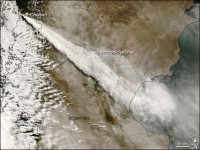By Joseph D’Aleo, CCM
The news is reporting a relatively large and long lasting volcanic eruption in Chile. According to the AP, the Chaiten volcano spewed lava and blasted ash 20 miles (105,000 feet) into the sky on Tuesday the largest ruption to date since the volcano came back to life last week, prompting a total evacuation of the provincial capital and other settlements. The volcano’s long lasting eruption has sent a thick column of ash into the stratosphere, streaming across Patagonia to the Atlantic.
In earlier stories, we noted that there are usually 8 to 12 volcanic eruptions on-going at almost all times. Most are the small guys which emit just lava or if eruptive have their ash and gas clouds only reaching thousands to a few tens of thousands of feet in the air, remaining within the troposphere where the ash and gases quickly falls or gets rained out within a few days or weeks.
It is the bigger eruptions that reach above this tropospheric layer into the more stable stratosphere that can have long lasting (up to several years) and extent effects (global). Pinatubo in 1991 reached over 110,000 feet and El Chichon 105,000 feet in 1982. Both Mt. St. Helens in 1980 and Cerro Hudson in 1991 reached around or just over 60,000 feet. The activity has not ceased and it is still possible a larger eruption will follow. The long lasting (5 days plus) nature of this eruption adds to the likelihood of an effect. But so far according to Simon Carn, a University of Maryland-Baltimore volcanologist who uses satellites to measure volcanic gases, Caiten had so far only emitted a few thousand tons of sulfur dioxide, small by comparison to Pinatubo which emitted 20 million tons. According to Alan Robock, a Rutger’s volcanologist at least a million tons must be emitted to really make a difference. He also noted that because of it high latitude location, any affect may be mainly limited to the Southern Hemisphere.

See larger image here. See video of the eruption here. See some amazing photographs here and here.
Note how much a major eruption can reduce incoming solar energy. This would add to the global cooling from the ocean flips and the a super long cycle 23 and possibly quiet solar cycle 24.

See larger graph here.
We have written on volcanic potential effects here and here.
One other note, back over a decade ago, there was some speculation that volcanic activity led to El Nino development as the ash reduced the thermal and thus pressure gradients and through them the equatorial easterlies, reducing cold water upwelliing in the eastern Pacific and favoring the sloshing east of warm water from the western Pacific. Anecdotally the super El Nino of 1982/83 followed El Chichon and the El Ninos of 1991/92 and 1992/93 followed Pinatubo and Cerro Hudson. Stay tuned as additional assessments are made of how much Chaiten may play a role on what’s ahead.




